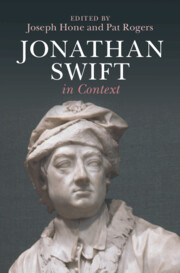Book contents
- Jonathan Swift in Context
- Jonathan Swift in Context
- Copyright page
- Contents
- Notes on Contributors
- Preface
- Acknowledgements
- Chronology
- Abbreviations
- Part I Personal
- Part II Publishing History and Legacy
- Chapter 5 Book Trade
- Chapter 6 Popular Culture
- Chapter 7 Translations and Reception Abroad
- Chapter 8 Critical Reception before 1900
- Chapter 9 Critical Reception after 1900
- Chapter 10 Reputation in Ireland
- Part III Literary Background
- Part IV Genres
- Part V The External World
- Part VI Social and Intellectual Topics
- Further Reading
- Index
Chapter 5 - Book Trade
from Part II - Publishing History and Legacy
Published online by Cambridge University Press: 02 May 2024
- Jonathan Swift in Context
- Jonathan Swift in Context
- Copyright page
- Contents
- Notes on Contributors
- Preface
- Acknowledgements
- Chronology
- Abbreviations
- Part I Personal
- Part II Publishing History and Legacy
- Chapter 5 Book Trade
- Chapter 6 Popular Culture
- Chapter 7 Translations and Reception Abroad
- Chapter 8 Critical Reception before 1900
- Chapter 9 Critical Reception after 1900
- Chapter 10 Reputation in Ireland
- Part III Literary Background
- Part IV Genres
- Part V The External World
- Part VI Social and Intellectual Topics
- Further Reading
- Index
Summary
This chapter provides a helpful primer to Swift’s relationship with the early eighteenth-century book trade. The first section focuses on the formats, sizes, prices, and lengths of Swift’s works, most of which were first published separately and not in anthologies. The second section examines imprints, in particular those of ‘trade publishers’, and how these imprints could be used as cover for anonymous and risky publications. The third and final section looks at the issue of copyright and how it shaped Swift’s decisions when publishing in London and Dublin. As the chapter shows, Swift showed loyalty to book-trade members who showed loyalty to him, including those in Ireland.
- Type
- Chapter
- Information
- Jonathan Swift in Context , pp. 35 - 42Publisher: Cambridge University PressPrint publication year: 2024

